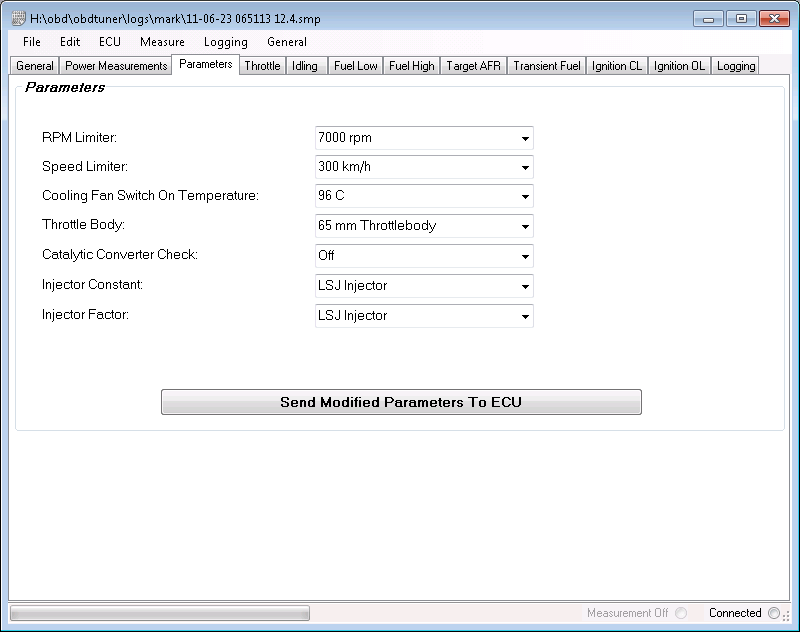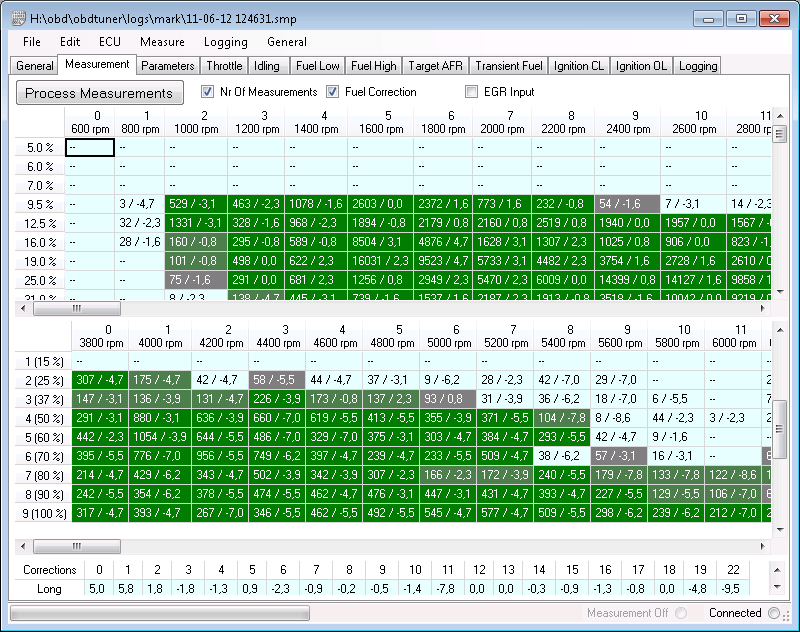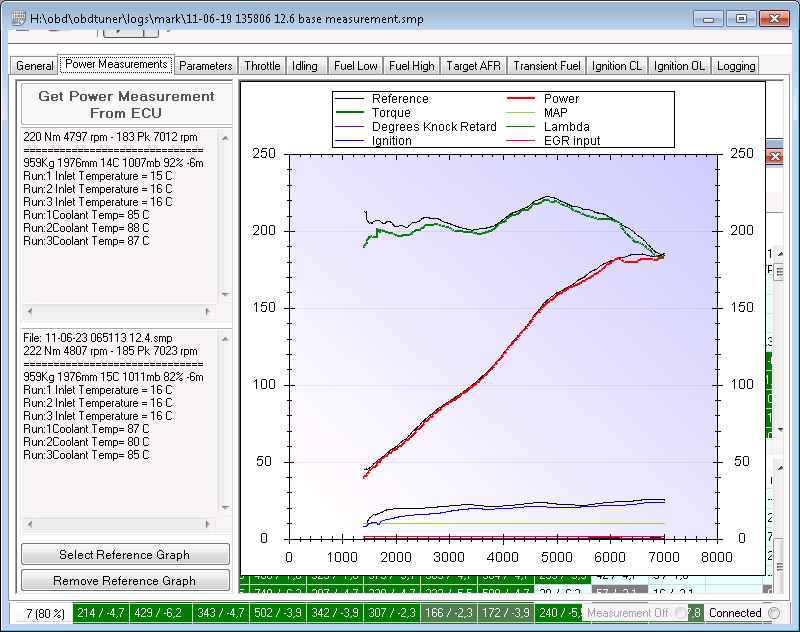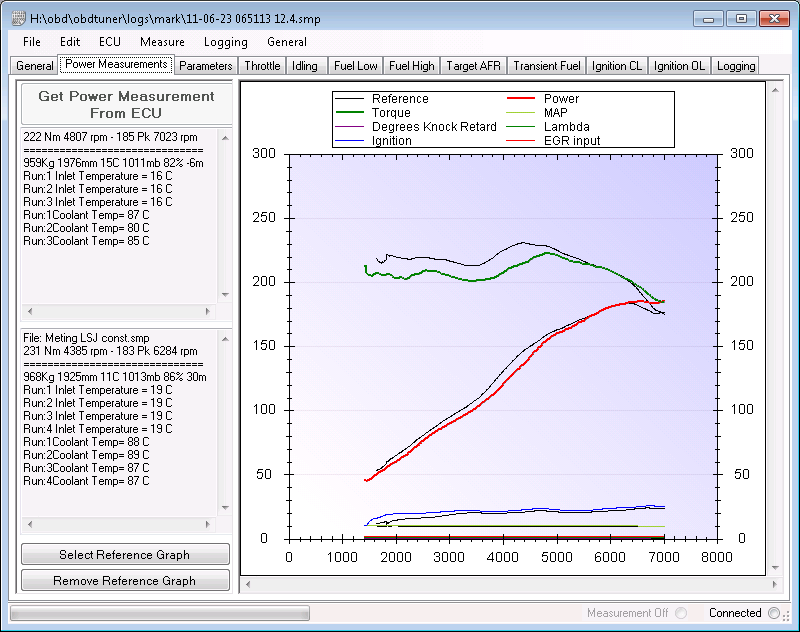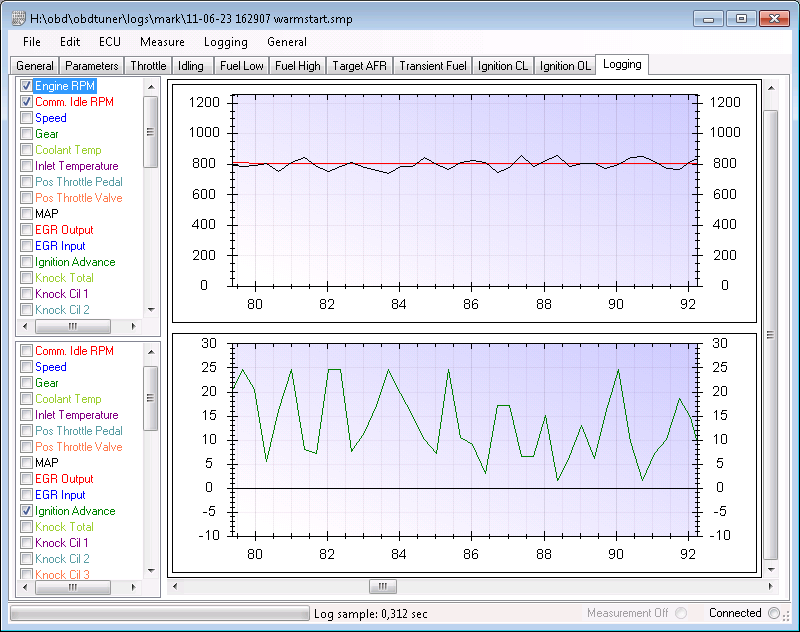| |||||
ECU calibration for camshaftsBefore I made the recent changed to the engine, I used OBDTuner to do a power measurement of the current setup.
The values OBDTuner produces are equal to the Hitec rolling road. After placing the LSJ injectors and Piper cams, the ECU needs to be recalibrated. To actually get the engine to start, the injector type needs to be changed.
Now the ECU knows the characteristics of the injector it can actually get the fueling a lot closer to what the engine needs, so starting the engine will actually work. First thing to start with now is learning the ECU how to make a 14.7:1 air/fuel mixture. So after driving around for about 1,5 hours with the ECU in learning mode, I got a nice log with all the required changes.
The learned changes can now be integrated into the main fuel table. Now the target AFR for full throttle and the ignition need to be setup. Based on previous experiences, it is best to run a lower AFR on engines with different camshafts. I did some testing with that and the power runs indicate you need to add more fuel in these situations. With normal camshafts an AFR of 13.1 or 12.9 delivers best power, but it doesn't anymore with the new camshafts. So I ended up with an AFR of 12.4. To get a more optimal ignition table, it is necessary to change the ignition in a number of steps and do a power measurement each time. After each power measurement the results should be closely inspected, especially if the knocksensor has detected any knock because the ignition was too early. By combining the results of all tests a new ignition table can be created. Changing the ignition can make some substantial improvements. This isn't directly reflected by increased peak torque or power figures, but can be clearly seen in the power graphs. Below is a power graph for the original ignition and the final version.
The final power results are in the graph below, compared with the engine configuration before placing the Piper camshafts and LSJ injectors.
The result is very standard for a change to more aggressive camshafts. Torque is moved to higher RPM and is held longer. At lower RPM there is a noticeable drop in the amount of torque. However, the dip in the torque curve between 3000 and 3500RPM is also less pronounced. This gives the engine a more linear response. The engine also runs smoother in higher RPM towards the rev limiter.
Based on power measurements done on a comparable engine with original camshafts but with a
different (Tullet) exhaust manifold, significant gains could be had by changing the exhaust
manifold. It seems probable this could lift the torque at lower RPM and lift the rather flat
power curve near the revlimiter.
As you can see torque is much higher at lower RPM, but the standard camshafts kill the peak power. Another thing that needs to be adjusted in the ECU is the idle of the engine. OBDTuner gives control of the target idle RPM depending on the coolant temperature, idle fueling and ignition.
However, it seems this is not enough to correct for the rough idle the new cams are giving. Below is a sound clip where you can hear the idle of the engine. You can clearly hear it is not running smoothly.
After a bit of logging with OBDTuner you can see what is happening during idling.
The upper graph shows the actual RPM of the engine. The horizontal line is the idle RPM the ECU is trying to obtain. Below is the ignition timing that is being applied. The timing seems to be quite erratic. This is not something that can be controlled by the tables available in OBDTuner at the moment.
The theory at the moment is the algorithm used
to control idle sharply monitors the crankshaft speed. Any deviation in what it expects results
in a quick correction. The base ignition timing when idling is quite late. The engine will not
produce a lot of power. This gives the ECU the possibility to quickly gain power by advancing the
ignition. This is a lot quicker then letting more air into the engine. The issue is being researched at the moment to see if it is possible to fix this. With the current idle it is unlikely the engine will make its MOT if the default 800RPM idle is maintained. When selecting a higher idle RPM it is possible to get the engine to idle smooth. |






